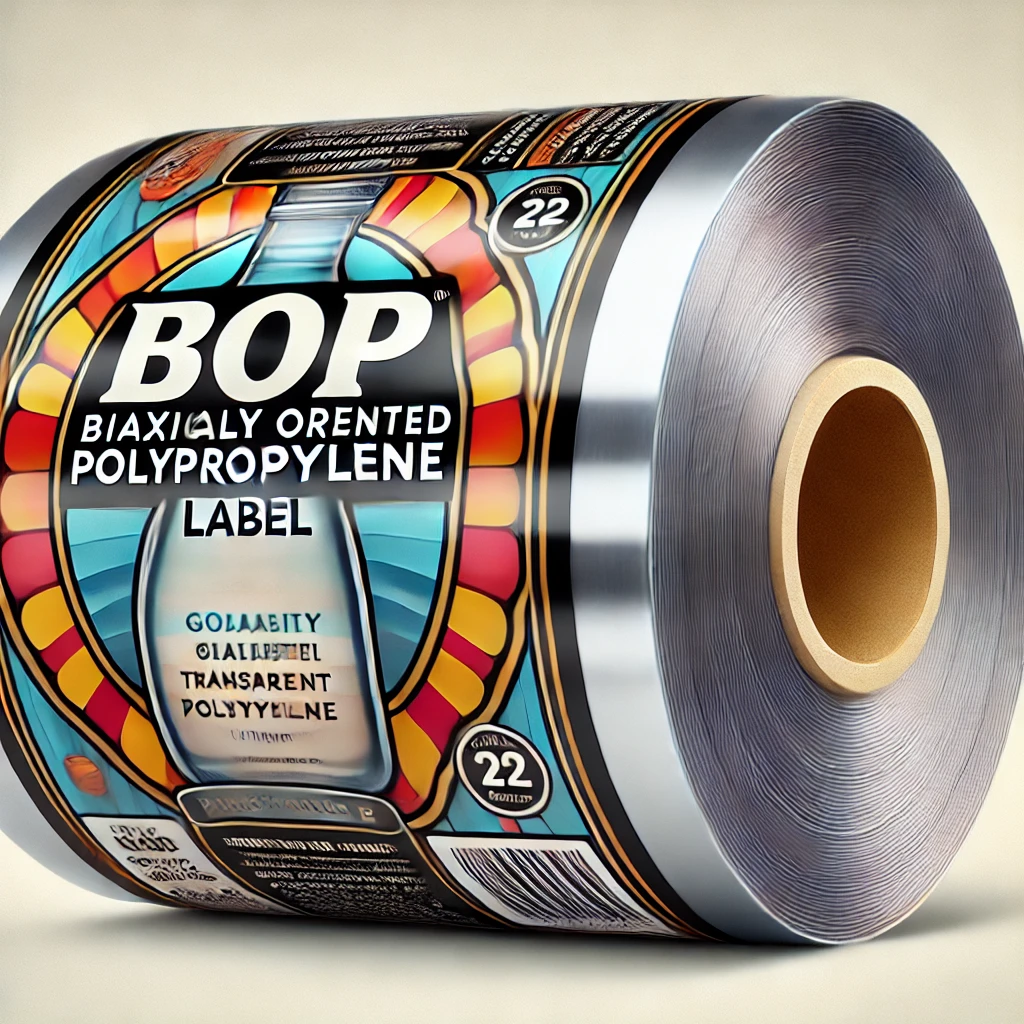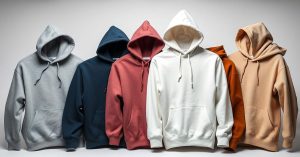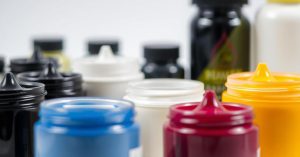Did you know over 70% of consumer product labels worldwide now use synthetic materials? BOPP labels lead the way because of their top-notch performance.
BOPP stands for biaxially oriented polypropylene. This label material is made by stretching polypropylene in two directions. This makes it very stable and versatile.
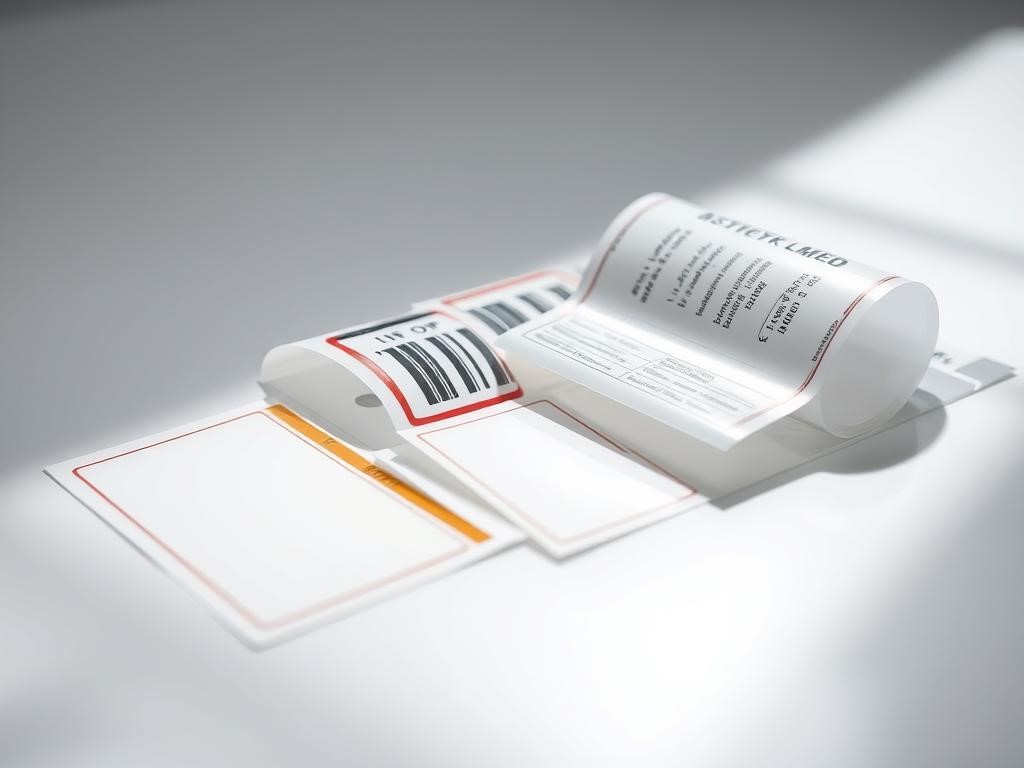
These labels are loved for their durability and good looks. They keep looking great even when exposed to moisture, chemicals, and changes in temperature.
Companies in the food, beverage, cosmetics, and household goods sectors pick this material. It’s clear, easy to print on, and doesn’t tear easily. The film’s structure protects well while showing off bright graphics.
Biaxially oriented polypropylene is also great because it’s affordable yet performs well. It’s perfect for businesses wanting to improve product looks without spending too much.
Key Takeaways
- BOPP stands for biaxially oriented polypropylene, a synthetic label material stretched in two directions
- These labels offer exceptional moisture, chemical, and temperature resistance
- The material provides superior clarity and printability for high-quality graphics
- BOPP labels balance performance benefits with cost-effectiveness
- They’re widely used across food, beverage, cosmetics, and household product industries
- The unique manufacturing process creates a more stable and versatile material than traditional options
Table of Contents
Understanding What Is a BOPP Label
Biaxially oriented polypropylene (BOPP) labels are a top choice for packaging. They are strong, clear, and can hold prints well. Knowing what BOPP is and how it’s made is key.
Definition and Composition of Biaxially Oriented Polypropylene
BOPP is a special polypropylene film that’s been improved. It starts as regular polypropylene, a plastic made from propylene.
The “biaxially oriented” part means the polypropylene film is stretched in two ways. This makes it different from regular polypropylene.
Stretching the material makes its molecules line up better. This gives BOPP its strong points: it’s tough, clear, and stable, yet thin.
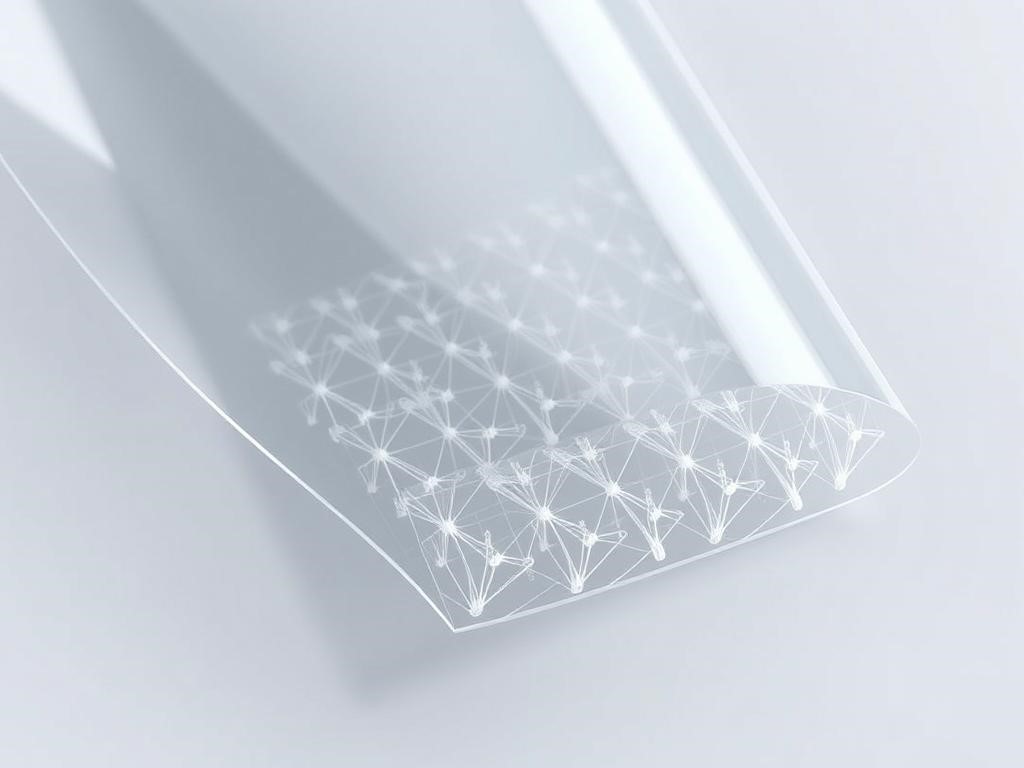
The Manufacturing Process: Stretched in Two Directions
Making BOPP film is a complex process. It starts with polypropylene pellets melted at 235°C (455°F). Then, the molten polymer is shaped into a sheet.
The sheet is then stretched in two ways. This is what turns regular polypropylene into the better BOPP material.
Stretching makes the film thinner but stronger and more flexible. It also improves its strength, clarity, and barrier properties.
Before being rolled up, the BOPP film gets special treatments. These make it better for printing and sticking.
The BOPP material is then ready for label makers. It can be clear, white, or shiny, depending on what it’s for. More layers are added to make the final BOPP label.
Types of BOPP Labels Available in the Market
BOPP labels come in many types, each for different packaging needs and looks. These labels are durable and versatile, making them great for many products. Knowing the types of BOPP labels helps businesses pick the best for their packaging.
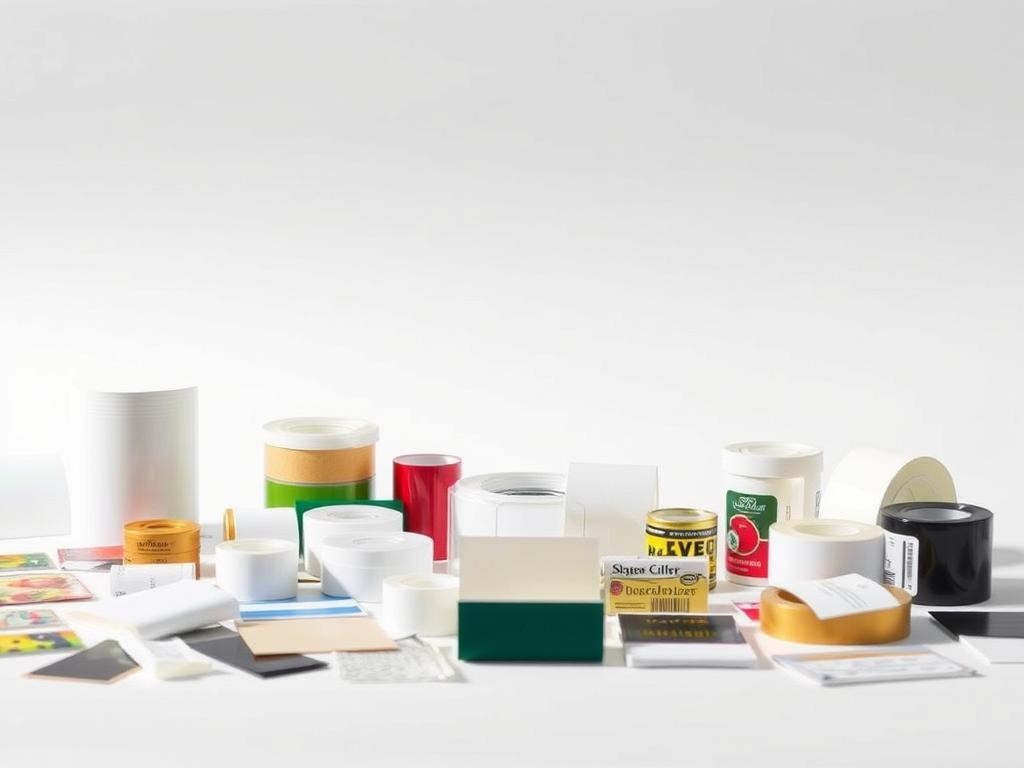
Clear BOPP Labels for Transparent Appeal
Clear BOPP labels look like there’s no label at all. This lets the product inside show through. It’s a clean look that many people like, which is why it’s great for premium items.
These labels are perfect for showing off what’s inside. They work well on glass or clear plastic. Craft breweries and food makers often use them for this reason.
The labels are clear, so any text or images look sharp and bright. This makes clear BOPP a good choice for brands wanting unique packaging.
White BOPP Labels: Matte and Glossy Options
White BOPP labels are very common and versatile. They come in matte and glossy finishes, each with its own benefits.
Matte white BOPP is great for reading because it’s not shiny. It’s good for products with lots of details or codes. It’s used for things like asset management and pharmaceuticals.
Glossy white BOPP makes colors and images stand out. It’s shiny and eye-catching. It’s often used for food, drinks, and other consumer goods to grab attention.
Metallic and Specialty BOPP Labels
Metallic BOPP labels are perfect for showing off quality or standing out. They have a shiny look that says luxury.
Silver BOPP has a mirror-like finish, great for high-end cosmetics and spirits. Gold BOPP adds warmth and luxury, ideal for gourmet foods and special editions. Both give a metallic look without the cost of real metal.
There are also holographic labels that change colors as they move. They’re fun for limited editions, kids’ products, or anything that needs to catch the eye.
Removable vs. Permanent BOPP Labels
The adhesive on BOPP labels is key for different uses. You can choose between removable BOPP and permanent labels.
Permanent labels stick well and stay put. They’re good for long-term use, like brand labels and warnings. They don’t come off easily.
Removable BOPP labels stick well but can be taken off. They’re great for temporary uses, like promotions or seasonal items. They’re also good for reusable containers.
Choosing between removable and permanent depends on the product’s purpose. Both types are durable and useful in many ways.
Key Benefits of Using BOPP Labels
BOPP labels are becoming more popular in the packaging world. They offer many benefits that traditional labels can’t match. Companies in various industries, like food and cosmetics, are choosing BOPP for its durability and looks.
These labels are tough, look great, and work well. They solve many packaging problems at once.
Superior Durability and Resistance Properties
Tough BOPP labels are great at handling daily wear and tear. Unlike paper labels, they don’t tear or scuff easily. This means your product’s info and barcodes stay clear.
The special structure of BOPP makes it very durable. It can handle a lot of stress without tearing. This is great for products that get handled a lot.
BOPP labels also handle temperature well. They work in cold places and not too hot places. This is good for products that change temperature a lot.
Moisture and Chemical Resistance
Water resistance is a big plus of BOPP labels. They don’t get ruined by water or humidity. This is perfect for products used in wet places.
BOPP labels also resist oils and chemicals. They don’t smudge or fade. This is good for products with oils or chemicals.
Aesthetic Advantages That Help Products Stand Out
Products need to look good on the shelf. BOPP labels help with this. They print well, showing off colors and details clearly.
BOPP labels can also look like they’re not there. This is great for clear containers. It makes products look more high-end.
BOPP labels come in many finishes. You can choose shiny, matte, or metallic. This lets brands create unique looks that match their products.
Cost-Effectiveness Compared to Alternatives
BOPP labels might cost a bit more than paper labels at first. But they save money in the long run. They last longer, so you don’t need to replace them as often.
Producing BOPP labels is also efficient. It uses less energy than some other materials. This makes BOPP labels more affordable for all kinds of businesses.
Benefit Category | BOPP Labels | Paper Labels | Polyester Labels |
Durability | Excellent resistance to tearing and scratching | Poor – tears and damages easily | Very good – slightly more rigid than BOPP |
Moisture Resistance | Excellent – maintains integrity when wet | Poor – deteriorates quickly | Excellent – similar to BOPP |
Aesthetic Options | Wide range – clear, white, metallic finishes | Limited – mainly opaque options | Good – fewer finish options than BOPP |
Cost | Moderate – excellent value for performance | Low initial cost, higher replacement rate | Higher than BOPP for similar applications |
BOPP labels are a smart choice for businesses. They offer great performance and are affordable. They’re perfect for products that face tough conditions but still need to look good.
Popular Applications for BOPP Labels
BOPP labels are a top choice for many uses. They are durable, moisture-resistant, and look great. This makes them perfect for many industries, from food to bathroom products.
Food and Beverage Packaging Solutions
BOPP labels are great for food packaging. They can handle tough conditions like moisture and freezing. This is why they’re perfect for refrigerated foods.
Beverage containers also benefit from BOPP labels. They keep their shape and stick well, even when wet. This is key for drinks that get condensation.
They also resist oils and acids found in foods. This means labels on condiment bottles and acidic drinks stay clean. BOPP labels are ideal for these situations.
Personal Care and Cosmetic Product Labeling
The personal care industry loves BOPP labels. They work well in humid places like bathrooms. Shampoo and lotion bottles look good with them.
Cosmetic brands also choose BOPP labels. They look premium and work well. This helps products stand out in stores.
Products with oils and chemicals also use BOPP labels. They keep labels looking good, even with harsh chemicals. This is great for nail polish removers and perfumes.
Solutions for Tricky Surfaces: Glass and Plastic Containers
Containers with odd shapes are hard to label. BOPP labels fit these surfaces well. They stick without wrinkles.
Both glass and plastic containers can be tricky. BOPP labels have special adhesives for these. This makes wine bottles and food jars look professional.
Products in extreme temperatures need labels that stay put. BOPP labels work from freezing to hot without losing stickiness. This is perfect for products in changing environments.
Household and Industrial Product Applications
Cleaning products and chemicals need labels that can handle moisture and harsh stuff. BOPP labels are great for this. They keep their shape and color.
In industrial settings, products face tough conditions. BOPP labels are durable for these. They work well for automotive fluids and industrial chemicals.
Warehouse systems also use BOPP labels. They resist moisture and temperature changes. This keeps barcodes and info clear for tracking.
BOPP Labels vs. Other Label Materials
BOPP labels are great for many uses, but they differ from paper and polyester. Each material has its own strengths for packaging. Knowing these differences helps businesses pick the right label for their needs.
BOPP vs. Paper Labels: Durability Comparison
BOPP labels last longer than paper labels. Paper labels tear easily and get damaged by moisture. They’re not good for products in tough environments.
BOPP labels, though, are tough against tears, moisture, and wear. They’re perfect for items that get handled a lot or are wet, like drinks and bath products.
Paper labels might be cheaper for simple, indoor uses. But BOPP labels are better for products that need to last longer or protect against the environment. Even though BOPP costs more upfront, it saves money in the long run.
BOPP vs. Polyester Labels: When to Choose Each
Polyester labels are the strongest. They handle heat well and last longer than BOPP. Polyester is best for very hot conditions.
BOPP is thinner and cheaper but still durable for most uses. Choose BOPP for standard needs and polyester for extreme heat.
Characteristic | BOPP Labels | Polyester Labels | Best For |
Heat Resistance | Moderate | Excellent | Polyester for high-heat applications |
Outdoor Durability | Good (1-3 years) | Excellent (3+ years) | Polyester for long-term outdoor use |
Flexibility | Excellent | Good | BOPP for squeezable containers |
Cost | Moderate | Higher | BOPP for budget-conscious projects |
Clarity (Clear Version) | Excellent | Good | BOPP for “no-label” look |
Printing Considerations: Water and Solvent-Based Inks
BOPP labels are great for printing. They have special treatments that help ink stick better. This makes them work well with many printing methods.
BOPP labels take both water-based and solvent-based inks well. This means they can be printed in many ways. It gives manufacturers more options.
BOPP labels also keep ink on the surface. This makes images sharp and colors bright. It’s perfect for products that need to look good, like fancy foods and cosmetics.
Environmental Considerations and Recyclability
BOPP is better for the environment than some plastics. It has a lower carbon footprint during making. This makes it a more sustainable choice in some cases.
BOPP film can be recycled in places that take polypropylene (recycle code #5). But, whether a whole label can be recycled depends on the glue used and if it’s on a recyclable container.
BOPP labels have some green benefits:
Material efficiency – BOPP is thinner but still works well. This means less material is used. Plus, BOPP lasts longer, so you need to replace labels less often.
When thinking about the environment, look at the whole packaging life. This includes if the container can be recycled and if the label helps or hinders that.
Selecting the Perfect BOPP Label for Your Products
Choosing the right label material is key for product success. BOPP labels are great for durability and looks. They work well for many uses.
Think about where your product will be. Does it face moisture, cold, or chemicals? BOPP stands up well to these challenges. For food, white BOPP is a top pick for its classic look and toughness.
Consider what you want your labels to look like. Custom BOPP labels come in many finishes. You can choose from clear, glossy white, or metallic. The finish affects how your labels look and how appealing your product is on the shelf.
Don’t forget about cost and how many you need. BOPP might be pricier than paper, but its lasting quality is worth it for tough products.
Bridging the Gap: When to Choose BOPP Labels
While BOPP labels excel in durability, moisture resistance, and vibrant clarity, not every packaging or branding need calls for synthetic materials. At Design Brand Print, we help businesses strike the right balance between functionality and aesthetic appeal by offering both high-performance BOPP labels and premium paper printing services.
Paper-based labels and printed materials remain a powerful choice for brands that prioritize texture, sustainability, and a handcrafted feel. They’re ideal for applications like luxury packaging, promotional inserts, custom stationery, and artisanal product lines, where the tactile experience matters as much as the visuals. Paired with elegant finishes like foil stamping, embossing, or soft-touch lamination, paper printing delivers a visual and physical impact that complements BOPP’s sleek performance.
In fact, many of our clients find success using BOPP for the product surface and premium paper for the packaging or branding collateral, creating a seamless and professional presentation that builds trust and boosts shelf appeal.
Understanding what a BOPP label is, and when to choose it over (or alongside) paper printing, gives your brand a strategic edge. Whether you’re launching a new product or refreshing your existing line, our team is here to guide you to the best printing services and label solutions for your goals.
Ready to find the perfect match for your label and packaging needs? Contact Design Brand Print today and let’s build something exceptional together.
Frequently Asked Questions about BOPP Labels
What are the main benefits of BOPP labels?
The benefits of BOPP labels are numerous. They offer excellent moisture resistance, making them ideal for products exposed to humidity or refrigeration. BOPP labels are highly durable and resistant to tearing, scratching, and oil. They provide outstanding print quality with vibrant colors that stand out on the shelf. Cost-effectiveness is another advantage, as BOPP is generally more affordable than materials like vinyl or polyester. Their versatility allows them to be produced in various finishes including matte white and glossy white, as well as clear labels for a “no-label” look. Finally, BOPP labels have good conformability to curved surfaces, making them suitable for bottles and containers.
Why is BOPP so great for food labels?
BOPP is so great for food labels because it meets the unique challenges of food packaging. Food products are often stored in refrigerators or freezers, and BOPP maintains its integrity in cold and damp environments without peeling or degrading. It provides excellent barrier properties against moisture, oils, and other contaminants that might be present in food environments. BOPP is also food-safe and compliant with FDA regulations for indirect food contact. Products like condiments, beverages, and dairy items that can be tricky to label due to condensation benefit from BOPP’s moisture resistance. The material’s clarity also allows for the creation of clear labels that showcase the product inside, a popular trend in premium food packaging.
When should I use a BOPP label for my products?
You should use a BOPP label when your products require durability combined with aesthetic appeal. BOPP is ideal for products that will be exposed to moisture, refrigeration, or handling, such as beverages, bath products, and food items. If your packaging has a curved or squeezable container that would be tricky to label with less flexible materials, BOPP is an excellent choice. When you need vibrant, high-quality printing that will stand out on the shelf, BOPP’s excellent printability makes it perfect. If cost-effectiveness is important without sacrificing quality, BOPP offers better value than premium materials like vinyl. Finally, for products that require a combination of functionality and visual appeal, BOPP provides the perfect balance.
What are the advantages of using custom BOPP labels?
The advantages of using custom BOPP labels are significant for brands looking to make an impact. Custom BOPP labels can be produced in virtually any shape, size, and design to perfectly match your brand identity. They accept a wide range of printing techniques, including digital, flexographic, and offset printing, allowing for detailed graphics and variable data. BOPP’s excellent printability ensures your brand colors appear vibrant and true. The material can be finished in various ways, including matte, gloss, or specialty finishes like gold BOPP for a premium look. Additionally, custom BOPP labels can incorporate functional features like tamper-evident properties or special adhesives for specific applications, giving you a label solution that’s perfectly tailored to your product needs.

